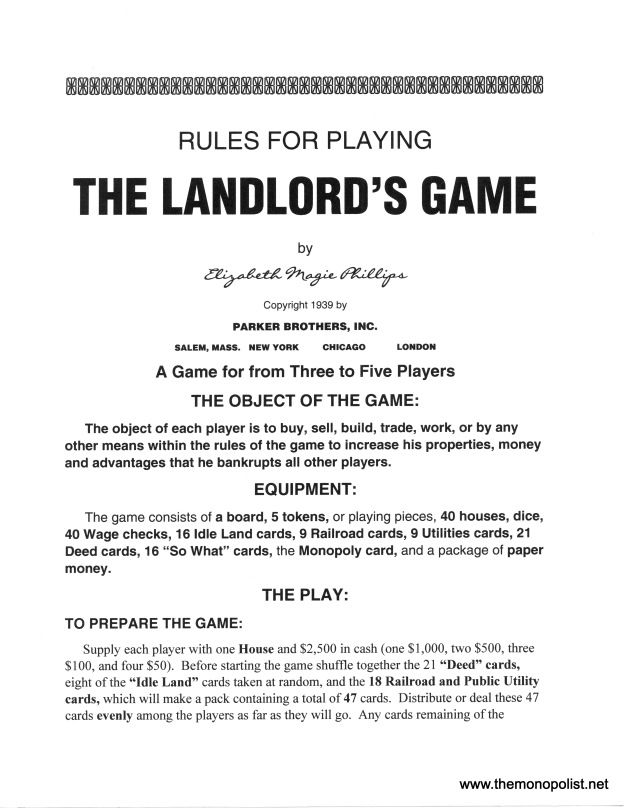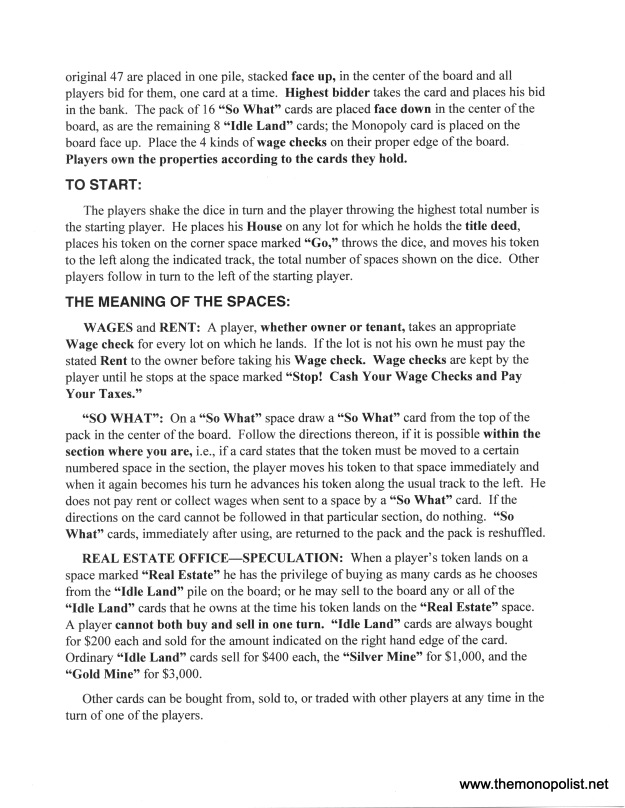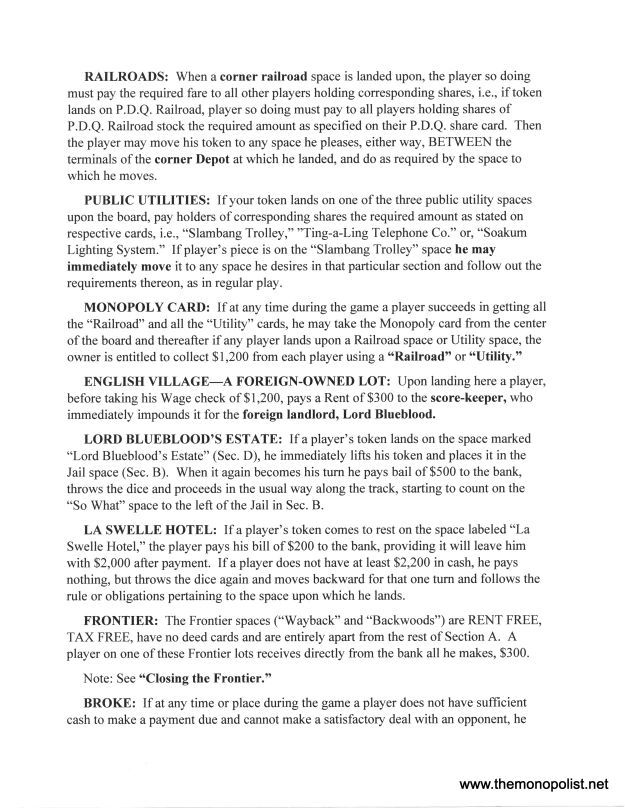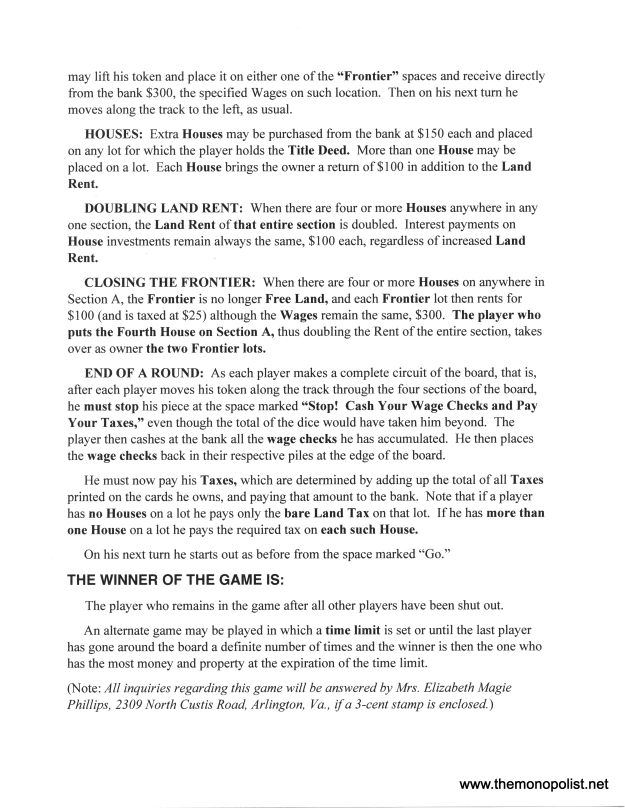In November 1935, Parker Brothers made a deal with Elizabeth Magie Phillips to purchase her second patent (#1509312) for The Landlord’s Game. Her earlier patent had expired by then.
This was then used by Parker to provide both legal protection for some features of the game Monopoly, which was fast on its way to being a national hit, and the means to acquire a patent on Monopoly itself (as an improvement of the Landlord’s Game patent).
In return, Parker Brothers paid Mrs. Phillips $500 and agreed to publish The Landlord’s Game. Over the years, some historians and authors of books on game history have singled this out as a completely one-sided deal, and part of a “billion dollar Monopoly swindle.”
However, in point of fact, there seems every reason to think that this is exactly the outcome Mrs. Phillips wanted and desired, and worked to bring about. This is apparent in her later recollections of these events in a journal devoted to the late economist Henry George (1839-1897), who she revered.
She had once worked in the Patent Office, and still had friends there in 1935. While Elizabeth Magie Phillips received four patents in her lifetime (three for games, and one for an improvement to typewriters), she had made no effort, up until this time, to enforce any of her rights. Why?
Because as a Georgist, she was opposed to monopolies, and patents are a form of legalized monopoly. On the other hand, she wanted recognition for her inventions. By taking out patents, she was ensuring she would get credit for her work.
Another factor, I believe, was the publicity stunt she pulled off in 1906, where she announced to the press that she was a “love slave,” and would sell herself off in marriage to the highest bidder. This caused a sensation, and gave her tremendous publicity, however, it may not have all been to her liking, as she ultimately did not sell herself off in marriage to the highest bidder.
Instead, she hoped to parlay her notoriety into a writing career. This did lead, apparently, to her meeting Albert Phillips, a wealthy publisher at the fringes of contemporary decency and the law, owner of the aptly named Climax Publishing Company, who she married in 1910.
Getting back to the 1930s, Mrs. Phillips had made no effort, over the years, to enforce her rights to either of her Landlord’s patents. But when, after a 30-year gestation period, the folk versions of her game began to succeed in the marketplace (first with Finance in 1932, then with Parker’s version of Monopoly, which came to them via Charles Darrow), suddenly there were three different firms vying for the rights to her patent– Knapp Electric, Parker Brothers, and Milton Bradley.
Of these, the only one she wanted to deal with was Parker, and only if George S. Parker himself, who she called “the King of Games,” would meet with her personally. Parker Brothers had passed on Landlord’s previously, but supposedly George S. Parker had suggested that she patent it. She knew that sales of Monopoly were taking off, but had no need (nor want) for the money, which would have been at odds with her Georgist principles. She bided her time, refusing to deal any of the three firms until George S. Parker himself came, hat in hand.
Mrs. Phillips had made two previous attempts to market Landlord’s, in 1906 and 1932. Very few copies were sold. Parker Brothers had published one of her games (Mock Trial) in 1910. Monopoly was a watered-down version of Georgist ideas, which was developed by the players from the first version of Landlord’s. She wanted to put Parker’s marketing muscle behind a real Georgist game.
The $500 was supposed to cover her expenses in having taken out a patent, but her main reward, getting Parker to publish The Landlord’s Game, did not come to pass until 1939. The sticking point between her and George S. Parker was the rules. Mrs. Phillips was a left-winger, but Parker was a conservative, not in the habit of marketing political games. He was also a stickler for clearly defined rules that eliminated ambiguities.
By 1939, Parker Brothers had already published two more of her games– Bargain Day and King’s Men. In 1936, she felt slighted by all the Parker publicity, falsely touting Charles Darrow as the “inventor” of Monopoly. Parker agreed to put out two more of her games, and for the rest of her life, listed her and Darrow as the co-creators of Monopoly.
By then, Parker Brothers certainly were aware that Darrow was not the true inventor of the game. They renegotiated their deal with him to reduce his royalty rate, in exchange for agreeing to cover any legal expenses he might incur, defending his new patent on Monopoly. Parker also wanted to spread Monopoly fever to other countries outside the United States. Darrow granted them the rights.
Certainly, if Elizabeth Magie Phillips had wanted a royalty on each Monopoly game sold, Parker would have given it to her, and further reduced Charles Darrow’s in turn.
The result of all this was a new version of The Landlord’s Game came out in 1939, with a game board designed to look as little like Monopoly as possible. The game was not a success, and Parker still had copies from their one and only press run on hand during World War II.
George S. Parker and Mrs. Phillips could not agree on the rules, so the 1939 game came with two different sets of rules. The Elizabeth Magie Phillips version has been readily available for years, through Thomas Forsyth’s web site. We present the Parker version herein, in a facsimile version transcribed from photographs.
-David Sadowski



